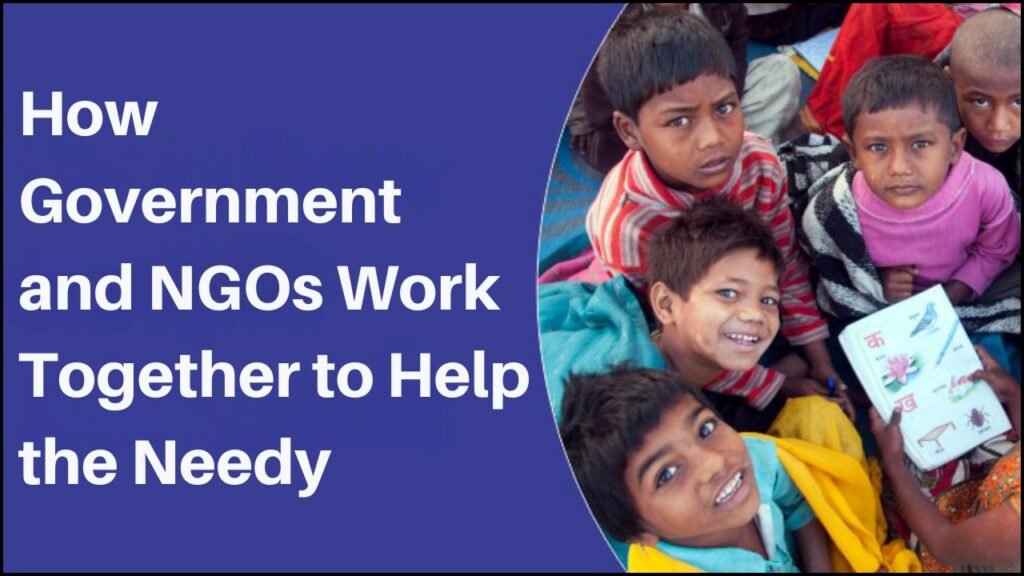
Collaboration between the government and NGOs has become essential in tackling poverty, homelessness, illiteracy, and health issues. Government institutions provide policies, funding, and legal frameworks, while NGOs focus on direct action, community engagement, and awareness. The combination of structure and flexibility helps reach people who are often ignored by mainstream systems. This partnership leads to better delivery of services to those in need.
Key Roles of the Government in Supporting the Needy
- Policy Making: The government designs national programs and schemes for the upliftment of poor, homeless, disabled, and marginalized people.
- Funding Support: Financial assistance is given to NGOs and welfare groups to implement programs in remote and rural areas.
- Monitoring and Regulation: The government ensures transparency and quality in services through regular checks, audits, and compliance guidelines.
- Welfare Schemes: Central and state governments create welfare schemes like MGNREGA, PMAY, Mid-Day Meal Scheme, and National Health Mission to support the poor.
- Public Infrastructure: Roads, schools, hospitals, and ration shops are built and maintained by the government to create access to basic needs.
Important Contributions of NGOs
- Community Outreach: NGOs work directly with families and individuals in slums, villages, and tribal areas, building trust and understanding local issues.
- Education and Awareness: Campaigns on health, hygiene, child rights, and girl child education are run by NGOs to empower underprivileged communities.
- Skill Training Programs: Vocational and digital literacy programs are organized by NGOs to help unemployed youth and women become self-reliant.
- Healthcare Access: Free medical camps, mobile clinics, mental health counselling, and vaccination drives are commonly conducted by NGOs.
- Emergency Relief: During disasters, NGOs distribute food, water, medicine, and shelter faster than many government bodies.
Common Areas of Collaboration
| Area | Government Role | NGO Role |
|---|---|---|
| Education | Building schools, hiring teachers | Running informal schools, adult education centers |
| Healthcare | Operating hospitals, supplying vaccines | Organizing health camps, spreading awareness |
| Women Empowerment | Providing schemes like Beti Bachao | Creating self-help groups, skill training |
| Child Welfare | Mid-day meals, ICDS programs | Saving street children, adoption programs |
| Employment | Job guarantee programs (MGNREGA) | Job placement, entrepreneurship support |
| Disability Support | Disability pension and aid | Providing mobility aids, special education |
| Environment | Policy-making, forest protection laws | Plantation drives, clean-up campaigns |
Successful Joint Initiatives
- Sarva Shiksha Abhiyan (SSA): Government-led program for universal elementary education where NGOs help reach out-of-school children through bridge courses.
- National Rural Health Mission (NRHM): NGOs join hands with government medical teams to carry out awareness drives, distribute medicines, and promote institutional deliveries.
- Integrated Child Development Services (ICDS): The government offers food, preschool, and health services, while NGOs provide support in counseling parents and tracking malnutrition cases.
- Swachh Bharat Abhiyan: Clean India initiative, where NGOs promote behavior change, build toilets, and manage waste in urban slums.
- Disaster Management: During floods or earthquakes, government agencies coordinate with NGOs to rescue, rehabilitate, and restore affected areas.
Advantages of Government-NGO Partnership
- Wider Reach: NGOs work in remote places where government services may not be easily available.
- Cost Efficiency: NGOs often work with low budgets and volunteers, reducing overall cost for delivering services.
- Speed and Flexibility: NGOs respond quickly during crises and do not face as much red tape as government bodies.
- Community Trust: NGOs build close relationships with locals, making implementation smoother.
- Innovation: NGOs bring creative ideas and pilot projects that the government can scale up.
Challenges in Coordination
| Issue | Explanation |
|---|---|
| Lack of Communication | Delays and confusion may occur without regular meetings and updates |
| Bureaucratic Delays | Both sides may face a lack of manpower, funds, or supplies |
| Mistrust or Politics | Some officials may doubt the motives or actions of NGOs |
| Resource Shortages | Both sides may face lack of manpower, funds, or supplies |
| Overlapping Programs | Repetition of efforts may happen due to poor planning |
Ways to Improve Cooperation
- Regular Dialogue: Frequent meetings, reviews, and consultations to align goals and strategies.
- Clear Roles and Responsibilities: Agreements that define the responsibilities of the government and NGOs.
- Joint Monitoring Systems: Shared tracking tools and audits to ensure transparency and avoid duplication.
- Capacity Building: Training sessions are conducted by the government for NGOs and vice versa to enhance professionalism and efficiency.
- Recognition and Incentives: Awards, tax exemptions, and other benefits can motivate NGOs to maintain high standards.
Examples of Well-Known NGOs Working with the Government
| NGO Name | Focus Area | Government Partnership |
|---|---|---|
| Pratham | Education for underprivileged children | Works with SSA for school enrollment drives |
| Goonj | Disaster relief and rural development | Collaborates in flood and earthquake response |
| Smile Foundation | Health and education | Supports NRHM and child education programs |
| SEWA | Women empowerment | Partners in self-employment and micro-financing |
| HelpAge India | Elderly welfare | Works with Ministry of Social Justice and Empowerment |
In Summary
The partnership between the government and NGOs creates a powerful force for social change. Government structures combined with NGO passion lead to effective, people-centered development. Joint efforts reduce gaps, increase access to services, and bring hope to those who need it the most. Strengthening this collaboration can ensure that no one is left behind.
Your Questions Addressed
Q1: Why is it important for NGOs and the government to work together?
A1: Working together combines the strengths of both sectors – the government provides structure and funds, while NGOs offer flexibility and field experience. This partnership ensures better service delivery.
Q2: How are government funds given to NGOs?
A2: Funds are usually given through grants, schemes, or CSR partnerships. NGOs must apply, meet criteria, and show proper documentation to receive funds.
Q3: Can small local NGOs work with the government?
A3: Yes, local NGOs can collaborate at the panchayat or district level, often through local welfare departments or disaster management cells.
Q4: What legal requirements must NGOs follow when receiving government support?
A4: NGOs must be registered, maintain proper accounts, and follow FCRA rules if receiving foreign funds. They must also submit utilization certificates.









